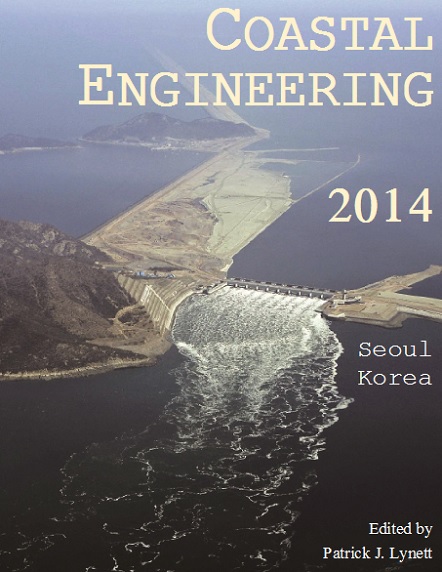Abstract
The color sand tracing to investigate the characteristics of sand movement on the tidal flat (Rokujo-gata in Mikawa Bay, Japan) was conducted in the winter season. Field measurements of currents and water level were also conducted on the flat to grasp the driving factors of currents and sand movement. Currents on Rokujo-gata were affected by wind in alongshore direction which is the north-south direction, and by a tidal oscillation in cross-shore direction. In the winter season, the southward currents are dominant. However the strong northward currents are occasionally generated. It is supposed that these strong currents move sand actively on the tidal flat. The color sand was placed on Rokujo-gata. The sand tracing was conducted during 6 months by sand sampling at 18 locations in the tidal flat and color sand grain counting was also conducted. The color sand was scattered soon after the placement. However it was demonstrated that the color sand remained on the tidal flat even after 6 months.References
Cabrera, L. L., and I. Alonso. 2010. Correlation of aeolian sediment transport measured by sand traps and fluorescent tracers, Journal of Marine Systems, 80(3), 235-242.
Hiramatsu. H., S. Tomita, S. Sato, Y. Tajima, S. Aoki and T. Okabe. 2008. Sediment Movement Mechanism around the Magome River Mouth based on Color Sand Tracer Experiments, Annual Journal of Coastal Engineering, JSCE, Vol.55, 696-700. (in Japanese)
Ikushima, N., H. Saito, and H. Nasu. 2012. A Field Experiment in a Tidal Flat on Hydrodynamic Effects of Scattering Artificial Gravels and Setting Up Fences That Enhance Settlement and Survival of Juvenile Short-neck Clam Ruditapes philippinarum, Journal of Fisheries Technology, 5(1), 75-86. (in Japanese)
Kato, K., N. Tanaka, T. Kondo, M. Akaishi and K. Terasaki. 1985. Field observation of local sand movement in the surf zone using fluorescent sand tracer (2nd report), Rep. Port Harb. Res. Inst, 24, 3-63.
Mariotti, G., and S. Fagherazzi. 2012. Channels-tidal flat sediment exchange: The channel spillover mechanism, Journal of Geophysical Research, 117, C03032, doi:10.1029/2011JC007378.
Ralston, D. K., and M. T. Stacey. 2007. Tidal and meteorological forcing of sediment transport in tributary mudflat channels, Continental Shelf Research, 27(10), 1510-1527.
Sakurai, I., and M. Seto. 1999. Behavioral Characteristics of the Juvenile Japanese Littleneck Clam Ruditapes philippinarum in response to Sand Erosion and Deposition, Scientific Reports of Hokkaido Fisheries Experimental Station, No.54, 41-46. (in Japanese)
Uchiyama, Y. 2007. Hydrodynamics and associated morphological variations on an estuarine intertidal sand flat, Journal of Coastal Research, 1015-1027.
Yamada. F., Y. Shirakawa, Y. Funakoshi, K. Tagawa, T. Hokamura, Y. Sakanishi, N. Kobayashi, A. Tamaki and A. Tada. 2010. Relative Importance of Tide and River Discharge on Sediment Transport on Intertidal Flat, Journal of JSCE, Ser. B2 (Coastal Engineering), Vol.66, 531-535. (in Japanese)

